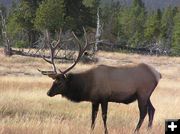

Bull Elk
Bull elk in Yellowstone National Park. Pinedale Online file photo.
|
|
Antlers Removed from Overly Aggressive Bull Elk
by Yellowstone National Park
October 3, 2005
Yellowstone National Park officials announced last week that it was necessary to tranquilize and remove the antlers of an overly aggressive bull elk that had been threatening the health and safety of visitor and employees.
This same animal (Number 6) had its antlers were removed during the 2004 fall mating season after it gored a park visitor, charged a park employee and damaged six vehicles in the Mammoth Hot Springs area.
Over the past several days, with cold weather bringing other bull elk into the Mammoth area, Number 6 had become increasingly more agitated, charging visitors within a 100-yard radius, as well as damaging several vehicles.
On Sunday, September 25, 2005, park staff tranquilized the animal near the Mammoth Hot Springs Terraces and removed his antlers. After removing the antlers, park staff remained with the animal to monitor his health and recovery. By early evening, Number 6 had recovered sufficiently and was acting normally--chasing smaller bulls and cows, eating and bugling.
Transporting the animal to a distant location was ruled out because over-stressed animals can choke to death on aspirated rumen. Even when successfully relocated, past history has shown elk shortly return to their original location.
Elk congregate at Mammoth Hot Springs and many other developed areas in the park at during the fall mating season. The large, muscular bulls bugle and display their massive antlers to intimidate other bulls and impress herds of cow elk.
Despite their often-docile appearance, elk are unpredictable, wild animals. They can run much faster than people can. Both cows and bulls can be very excitable and dangerous at this time of year. Sharpened tines on the large antlers of mature bulls are very effective weapons when wielded by animals weighing an average of seven hundred pounds. They may mock fight with trees or vehicles, spar with other rivals, or chase visitors who stray too closely.
During the fall mating season, additional park staff are on duty to help keep visitors at a safe distance from all elk. But they canít be everywhere. Park visitors are reminded that they are responsible for their own safety in the park. Park rules require people to stay at least 25 yards away from elk, bison and other large animals and at least a football field away from bears.
Park Rangers urge visitors to use binoculars, zoom lenses and avoid using the cameraís flash in order to capture this spectacular fall display at a safe distance rather than approach animals too close and risk injury.
|
